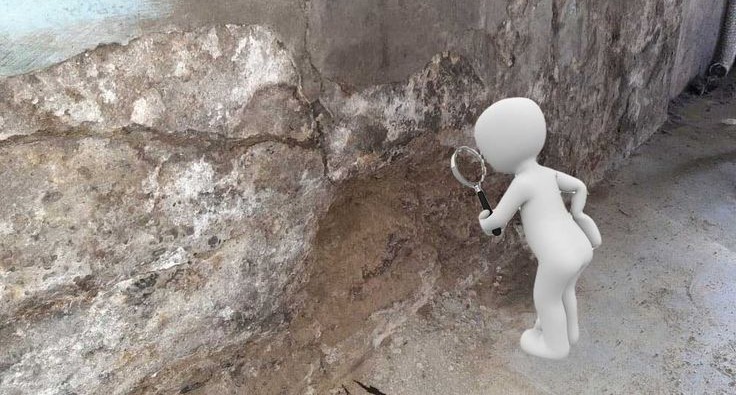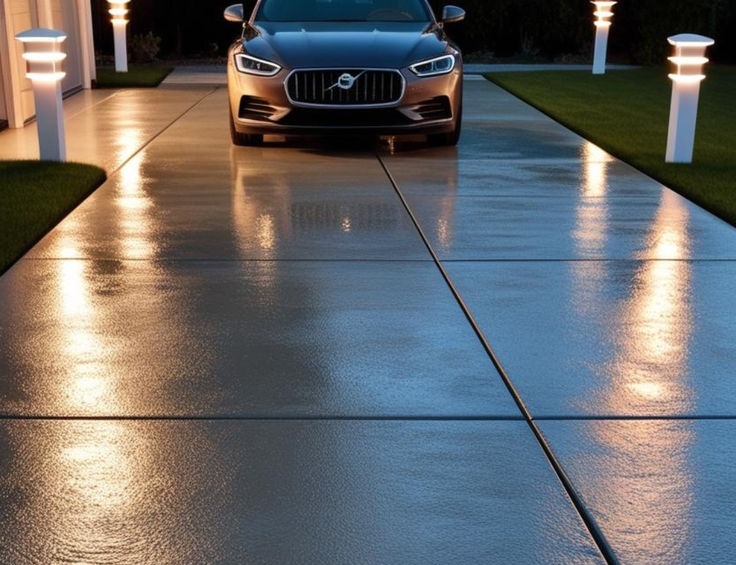When building or upgrading a home in Austin, Texas, one crucial decision often gets overlooked: the driveway. It’s more than just a path to your garage — it’s a long-term investment in your property’s function, beauty, and durability. In Austin’s unique weather, concrete driveways stand out as a top-tier choice. In this post, we’ll take a deep dive into the concrete driveway benefits, explore the advantages of concrete driveways, and explain why they are perfect for Austin’s climate.
Here are the Top Concrete Driveway Benefits for Austin Homes :
1. Unmatched Durability in Extreme Heat
Austin summers are no joke. With temperatures often soaring past 100°F, your driveway material needs to be resilient. Unlike asphalt, which softens and warps in extreme heat, concrete remains firm and structurally stable.
Concrete is a rigid material made from cement, water, and aggregates that cures and hardens into a solid slab. Once cured, concrete can withstand years — even decades — of hot weather without deteriorating.
Key Advantage:
Concrete driveways can last 30+ years with proper installation and minimal maintenance. That’s a solid return on investment.
2. Low Maintenance and Longevity
Concrete is a low-maintenance superstar. While other driveway materials like gravel or asphalt require constant reapplication, resealing, or patching, concrete only needs occasional sealing and cleaning.
For Austin homeowners who want a “set it and forget it” driveway solution, concrete is ideal. Stains, leaves, and oil spills are easily cleaned with a pressure washer or broom.
Bonus Tip: A high-quality sealant applied every few years can keep your concrete driveway looking fresh and new.
3. Aesthetic Appeal and Customization
Gone are the days when all concrete looked plain and gray. Today’s concrete driveways can be stamped, stained, brushed, or polished to suit your home’s architecture and boost curb appeal.
Whether you’re aiming for a sleek modern look or a warm, rustic vibe, concrete offers a wide range of customizable design options.
Popular design options include:
- Stamped patterns (brick, stone, woodgrain)
- Colored concrete in earthy or bold tones
- Exposed aggregate for texture and traction
Why it matters in Austin: Homes here often feature bold design elements — concrete lets you match your driveway with your home’s unique style.
4. Cost-Effective Over Time
Yes, the initial cost of concrete is higher than gravel or asphalt. However, its long lifespan and low maintenance make it more affordable over time.
Think about it: With asphalt, you may need to resurface or patch every 3–5 years. With concrete, you likely won’t need to touch it for 15–20 years. That saves you money, time, and hassle in the long run.
Pro Insight: Concrete’s return on investment makes it a favorite among real estate professionals looking to boost home resale value in Austin.
5. Eco-Friendly and Heat-Resistant
Concrete driveways are environmentally friendly for several reasons:
- They reduce the urban heat island effect. Asphalt absorbs heat and radiates it back into the environment. Concrete reflects sunlight, helping keep your property cooler.
- They’re recyclable. Old concrete can be crushed and reused in other construction projects.
- They help manage stormwater. With proper grading or the use of pervious concrete, your driveway can help direct rainwater into the soil instead of into gutters and drains.
Ideal for Austin: In a city prone to dry spells and flash flooding, using materials that help with water percolation and reduce heat is a win.
6. Safety and Surface Performance
Concrete provides a non-slip surface, which is essential during Austin’s occasional rains and storms. Its bright color also enhances visibility at night, and its solid surface reduces the likelihood of trip hazards, unlike gravel or cracked asphalt.
Plus, because it doesn’t get as soft in the heat, you don’t have to worry about tire tracks or indentations when parking during the peak summer heat.
Concrete Driveway Pros and Cons
Installing a driveway isn’t just about choosing what looks good. You need a material that can stand up to the elements, suit your lifestyle, and offer a good return on investment. Concrete consistently ranks as one of the best options, especially in a climate like Austin’s. Let’s dive deeper into the pros and cons so you can make an informed decision.
Pros of Concrete Driveways
1. Extremely Durable in Hot Climates
Austin’s weather can be punishing — relentless sun, high temperatures, and occasional flash floods. Many driveway materials degrade quickly in such conditions, but concrete thrives. It’s engineered to resist:
- UV damage that weakens other materials over time
- Heat-induced softening (unlike asphalt)
- Erosion from rain or runoff
Concrete’s hardness and thermal stability make it perfect for driveways in Central Texas, where it endures daily sun exposure without warping or cracking prematurely.
2. Low Maintenance
Once installed, concrete requires very little upkeep. Unlike gravel, which scatters, or asphalt, which needs resealing every few years, concrete simply requires:
- Occasional sweeping or hosing down
- Resealing every 3–5 years (optional but recommended)
- Prompt stain cleanup (e.g., oil or tire marks)
This minimal maintenance means less hassle and lower lifetime costs for homeowners.
3. Aesthetic Versatility
Concrete doesn’t have to be boring. Thanks to modern techniques, it can be:
- Stamped to mimic stone, brick, or tile
- Colored to match your home’s theme
- Textured or polished for a refined look
Whether you’re going for a clean minimalist vibe or a more decorative, high-end appearance, concrete can be tailored to reflect your personal style. It enhances curb appeal — a definite plus for resale value.
4. Long-Term Cost Efficiency
While the upfront cost of concrete may be higher, it pays off over time. You won’t be spending money on frequent repairs, patching, or resurfacing.
Consider this:
- Lifespan of concrete: 30+ years
- Lifespan of asphalt: 15–20 years (with maintenance)
When you factor in fewer replacements and reduced maintenance, concrete proves to be the more economical option over decades.
5. Eco-Friendly and Safe
Concrete supports sustainability and safety in multiple ways:
- Reflects sunlight, reducing heat absorption and contributing to lower surface temperatures (unlike blacktop)
- Minimizes stormwater runoff when designed with proper slope or pervious options
- Non-toxic and recyclable — old concrete can be repurposed in roadbeds or other construction
On the safety front, concrete provides a non-skid surface, making it safer for kids playing, pets running around, or elderly homeowners walking to the mailbox — even during Austin’s occasional rains.
Cons of Concrete Driveways

1. Higher Upfront Cost
One of the most common deterrents for homeowners is the initial price tag of a concrete driveway. Installing a concrete driveway typically comes with a higher initial cost, which can vary depending on several factors such as the thickness of the slab, the type of reinforcement used, the chosen finish, labor rates in your area, and any site preparation required.
- Thickness of the concrete slab (standard is 4–6 inches)
- Type of reinforcement (rebar or wire mesh)
- Finishing options (stamped, colored, polished, broomed, etc.)
- Labor costs specific to Austin’s market
- Site preparation needs, such as grading or demolition of old materials
Still, while the cost can be a barrier, it’s important to understand that concrete typically lasts longer and requires less ongoing maintenance, which can offset the expense over time. But if you’re on a tight budget, it may not be ideal for short-term financial planning.
2. Longer Installation Time and Curing Period
Installing a concrete driveway isn’t a one-day job. The process involves multiple steps:
- Site prep – removing debris, excavating, grading
- Setting forms – outlining the shape and borders of the driveway
- Laying sub-base – usually gravel or compacted soil to prevent shifting
- Pouring and leveling – applying the concrete mix and ensuring proper slope
- Finishing – smoothing, texturing, or stamping the surface
- Curing – letting the concrete set and strengthen
The critical point here is the curing phase, which takes at least 7 to 10 days before the driveway is ready for light vehicle traffic, and up to 28 days for full strength. During this time:
- You cannot park or drive on it
- Foot traffic should be minimized
- Exposure to heavy rain or extreme temperatures may require protective measures
For homeowners with only one parking space or no street parking available, this can be highly inconvenient.
3. Susceptibility to Cracking
Even though concrete is durable, it isn’t invincible. Cracking is a known drawback, often caused by:
- Soil movement or shifting subgrade
- Tree roots growing beneath the driveway
- Thermal expansion and contraction due to temperature changes
- Improper installation or insufficient joints
Once cracks appear, they’re often permanent, and although they can be sealed, they still affect the visual appeal. Even small cracks can worsen over time if water seeps in and freezes (less common in Austin, but possible in colder seasons).
Using proper reinforcements like rebar, expansion joints, and professional-grade sealants helps reduce this risk, but it adds to installation complexity and cost.
4. Stains Are Difficult to Remove
Concrete is porous by nature, which means it can absorb liquids. Oil leaks from vehicles, rust stains from patio furniture, or even fertilizer runoff from nearby lawns can stain the surface.
Without regular sealing:
- Motor oil and transmission fluid can permanently darken the surface
- Mold and mildew can grow in shaded or damp areas
- Tire marks can bake into the surface under the Texas sun
While many of these stains can be treated with power washing or commercial cleaners, preventing stains (by applying a concrete sealer every few years) is the more effective approach. Again, this adds to long-term maintenance.
5. Repairs Aren’t Always Seamless
Unlike asphalt, where patching is easy and blends well, concrete repairs are more visible. If a section of your driveway needs to be removed and replaced:
- The new patch often doesn’t match the color or texture of the original
- Stamped or decorative finishes are very hard to replicate
- It may create a visually inconsistent surface
For homeowners who value aesthetics and curb appeal, this can be frustrating. In many cases, if the damage is widespread or severe, it’s often better to replace the entire driveway rather than patch it, which adds to cost and downtime.
Summary | Top Concrete Driveway Benefits for Austin Homes
| Drawback | Why It Matters |
| High Initial Cost | More expensive than asphalt or gravel; may not suit all budgets |
| Longer Installation Time | Includes curing time, leaving you without a usable driveway for up to 10 days |
| Cracks Over Time | Susceptible to soil movement and temperature changes; hard to hide |
| Prone to Stains | Oil, rust, and tire marks can discolor the surface unless sealed regularly |
| Difficult Repairs | Fixes often don’t match the original look; cosmetic consistency is hard to maintain |
Final Thoughts: Is a Concrete Driveway Right for Your Austin Home?
If you’re a homeowner in Austin looking for a long-lasting, stylish, and climate-resilient solution, a concrete driveway is the smart choice. Its benefits outweigh the cons, especially when you factor in durability, safety, aesthetics, and long-term savings.
Whether you’re replacing an old surface or building from scratch, concrete driveways offer lasting value that aligns with Austin’s environmental demands and design sensibilities.











